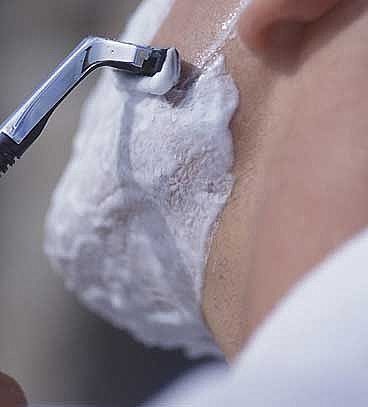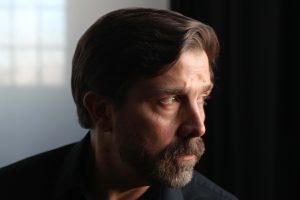
Cincinnati, OH. Standing before the dripping bathroom mirror while the shower haze slowly melts, I’m startled once again that my beard’s gone missing. It lasted seven years – longer than any predecessor – but I shaved it off in July, and I’m still not used to it.
It went in minutes: a quick, painless death. I’d come to see the deed as necessary, though I needed a push in the end. My wife, taking a page from the game show, Jeopardy, gave me an answer in the form of a question: “When do I get to see your face again?” What’s more, she said it in that tone and cadence a gentleman learns to pay attention to.
There were people at work who’d never seen me without it, so I postponed shaving until my move from one office to another. That kept down idle chatter: all those comments and unsolicited opinions – pro-beard and con – with me, an introvert, forced to endure it all. Call it a stealth shave. I’ve been telling folks from the old office who’ve seen me since that I’m in the witness protection program.
I birthed that beard in the Grand Canyon: sixteen days rafting the Colorado River, far from the nearest mirror. I couldn’t look at myself if I wanted to, and only a scratchy neck told me something was different. My fellow rafters, most of them old and dear friends, endured my slovenly appearance, but they weren’t looking so fresh themselves, with nothing but chilly river water to bathe in.
Before that, I grew a short-lived goatee on a medical mission to Honduras. My wife wasn’t home when I returned – my in-laws were watching the kids while we were away – and I met her as she walked in the door, late at night, with the lights off. She kissed me when she heard my voice, but was taken aback by the new fuzziness. “I hope this is my husband I’m kissing,” she said. I hope she doesn’t ask that question often.
When it comes to hair in our household, my wife has a permanent seat on the Security Council. Not that she uses her veto often. She typically communicates in hints, and the Jeopardy question was the latest in an escalating series. Still, she’s the one who has to look at me, and it’s her kisses that matter.
Even if she’d said nothing, a beard is – and has been since the invention of the razor – a choice. Shaving, unlike not shaving, is quick and dramatic. Therein lies the dilemma. If I decide I don’t like the new – no, make that old – look, when is there time to grow out another, time away from questions as predictable as the sunrise: “Are you growing a beard, or did you just not shave?” As if there were a difference. So now I’m stuck with shaving again, every day.
Not that my beard was maintenance free. It demanded frequent trimming, constant border patrol. I leaned over the sink, squinting in the morning light, a pair of surgical scissors in hand to clip hairs arcing wildly astray, littering the white sink below with a snowfall of dark and delicate commas. Some commas had grown whiter with the years. Was it laziness or vanity that kept me from shaving? Something more profound?
Next summer, for instance, I go in for a new driver’s license. Now nearly four years old, the current photo makes me look like a Santa Fe massage therapist. At airport check-in lines, bored security personnel scowl when I hand them my ticket and license. “Who’s he trying to fool?” they seem to ask, rapidly alternating their gaze from card to potential con man. They’ve always let me through so far. It is me in that old picture, after all. Or is it?
Sociologist Grant McCracken wrote a book about American hairstyles from the 1950’s on, in which he claims, “there was a time when …self-invention was impossible.” Fortunately, he reassures us, all that has changed:
“We all live lives now of active transformation. This is one of the great accomplishments of our cultural tradition and one of the great joys of our personal lives.”
The source of this newfound joy is hairstyling, and the title of the book in question is, Big Hair: A Journey into the Transformation of the Self. For McCracken, the border between hairstyle and self is indistinct at best, and the great liberator of an American nation’s captive selfhood was none other than Vidal Sassoon. Sassoon, McCracken tells us, cut hair naturally, as part of the head rather than its ornament. A Sassoon cut, if disturbed, was meant to fall back into place at the tap of a hand, making it maintenance free. That explains, I’m sure, why Sassoon developed a lucrative business selling hair care products with which the newly liberated might maintain this maintenance free look.
Other times and places have been less certain of the relationship between hair and identity. Thomas Aquinas devoted an article of the Summa Theologiae to refuting numerous assertions that the life to come requires neither hair nor nails (ST supplement, 80:2). The elfin appearance of extraterrestrials inhabiting the pages of the National Enquirer and – so I am reassured by the devout – Area 51 in Nevada, suggests superior intelligence don’t need no stinkin’ hair. Neither did Telly Salvalas and Yul Brynner, although it was precisely their startling hairlessness that rendered them instantly recognizable.
I know men who seem to live peaceably with their beards. Some pull it off well, others exude an air of pretence, like the local psychiatrist with his silly, affected accent – or is that a corrected stutter? – and immaculately combed Vandyke. When I learned he left his wife for a much younger woman – an unemployed actress – I wasn’t surprised. Men who spend that much time on so little hair ought not be trusted.
If my beard had something to do with my identity, what was its message to the world? A friend of mine, bald and bearded, claims his look announces to grateful women everywhere a man with testosterone to spare. Odd. I’m told women generally look for more in male companions than signs of hormonal excess.
Men in the sixties grew beards as manifestos of rebellion. Now business-suited corporate executives use sixties rock anthems to peddle trendy cars. Then and now, the key is that bourgeois chestnut, “self-expression.” Was there ever a generation so obsessed with external correlates to an alleged interiority? If my beard declared some secret of my identity, it must be that I didn’t like to shave.
It’s true – I don’t. I’ve never mastered the art. I set off for work with toilet tissue pasted to nicks on my cheek. Shaving seems a waste of valuable morning time and comes with fashion absurdities of its own, what with the preposterously rising number of blades per razor featured on expensive-looking television commercials. Saturday Night Live’s very first show included a mock commercial for the Triple Trac razor, complete with a cartoon demonstrating how three blades leave one’s face “smooth as a billiard ball.” The fake spot ended with the words, “The Triple-Trac. Because you’ll believe anything.” Madison Avenue went on to prove that.
It’s odd how many advertising minutes are devoted to men’s razors, since women – at least North American women – have far more territory to denude. Yes, it’s disturbing holding a razor to one’s neck, but at least I don’t scrape it down my legs and under my arms.
Or elsewhere.
Having chosen my parents well, I’m undeservedly blessed with a full scalp of hair and no desire to alter it. I’m no Telly Salvalas wannabe. As a pediatrician, though, I’ve seen my share of startling haircuts: male and female, child and parent. If McCracken is right, there’s a universe of active transformation out there, crashing on the cultural shore in bouffant waves. The evidence is in the hair: mohawks and mullets; colors not otherwise found in nature; parts, trims, and close shaves unusual in location and scope.
The evidence is also in the skin: tattoos, piercings, brandings and, increasingly, botox. (Botox for twenty-year-olds is a concept I’m still trying to get my head around: what’s the attraction and where are they getting it?) Some of my patients and their parents have artistic tattoos and tasteful piercings, though my impression is that these folks get what they pay for. I’ve also seen aesthetic atrocities and serial mutilations of once healthy body parts. Humans have been adorning and altering their exteriors for millennia – often in ways that immerse in rather than isolate from community – but some of what now passes for beautification carries the distinct odor of compulsion: frantic, repetitive attempts to assert individuality in a lonely, uncaring world.
This unquiet desperation reminds me of O. E. Parker, protagonist of Flannery’s O’Connor’s story, “Parker’s Back,” an incisive and disturbing comedy that mulls immensities like confirmation/chrismation, gnosticism and docetism without naming them. When he was fourteen, O. E saw a tattooed man at a fair. He didn’t see him up close – “he was near the back of the tent, standing on a bench,” – but the man’s skin “seemed from Parker’s distance…a singular intricate design of brilliant color.”
The image leaves Parker changed, inspired, “lifted up as some people are when the flag passes.” O’Connor goes on:
“Until he saw the man at the fair, it did not enter his head that there was anything out of the ordinary about the fact that he existed. Even then it did not enter his head, but a peculiar unease settled in him.”
Parker responds by covering his skin with tattoos: an eagle and cannon; a heart with his mother’s name on it; tigers, panthers, cobras and hawks; Queen Elizabeth and Prince Philip, acquired at parlors across the South or at ports of call while in the navy. His unease becomes obsession:
“Parker would be satisfied with each tattoo about a month, then something about it that had attracted him would wear off. Whenever a decent-sized mirror was available, he would get in front of it and study his overall look. The effect was not of one intricate arabesque of colors but of something haphazard and botched. A huge dissatisfaction would come over him and he would go off and find another tattooist and have another space filled up…His dissatisfaction, from being chronic and latent, had suddenly become acute and raged in him. It was as if the panther and the lion and the serpents and the eagles and the hawks had penetrated his skin and lived inside him in a raging warfare.”
In a few short paragraphs, O’Connor unveils an interior drama of mimetic desire, famished craving and disintegration of the self-constructed self into chaos, impotence and rage.
I don’t know how many of my multiply tattooed and pierced acquaintances follow O. E. Parker’s interior script. Unlike the new celebrity atheists (Hitchens, Dawkins, Harris, et al.), whose writing suggests a supernatural ability to divine the profoundest longings and motivations of persons they’ve never met and reduce them to psychological banalities, I don’t make a habit of pontificating about my neighbor’s neurophysiology. But the stories my patients and their parents tell me suggest O. E. Parker’s very much alive and unwell. So do the scars – visible and spoken – they carry, the pause before they smile, the wary vacancy in their eyes.
Adolescence, say those experts who chat with perky interviewers on television, is a time for trying on new identities: intellectual, sexual, tonsorial. Nowadays, of course, it’s hard to decide when adolescence ends: if fifty is the new thirty, twenty-five is the new fifteen. With added years of playtime, identity turns – for some, at least – into an extended shopping experience. (The torque in Erik Erickson’s grave must be appalling.) And there are so many packaged identities to choose from, each with its own line of accessories.
I cringe for children – mine and others’; kids who may never understand there’s more to life than increasing its choices. I cringe for their equally bewildered parents. Among the choices we each must make, surely there are weightier decisions than how to style one’s hair and adorn one’s skin.
But here I am, standing in front of the steamed mirror, my middle-aged flesh beaded with water, as I once more consider a beard. Or am I wondering about my identity? At my age, am I not past all that? Or is this an existential crisis, the midlife moment immediately preceding the new, red sports car and family-wrecking affair? Imaginative as I am, all I can picture down that road is an elderly Hugh Hefner, who advised readers in a 2004 book: “It is a good idea not to fall asleep while you’re actually having intercourse.” Ah! The passion!
It’s difficult enough deciding whether or not to use the razor; when will I ever have time to consider all the implications of some superficial self-transformation? And when that upheaval grows tedious, as it certainly will, what desperate gesture will grant another temporary stay of boredom? In any case, I won’t act on any of this. Not today. I have to get to work and the clock is ticking. Today, I’ll stick with a shave. Before doing anything drastic, I’ll check with my wife.





14 comments
regrow hair
The question of how to start growing a beard is fairly easy to answer. It’s the issue of beard shaping, beard trimming and beard maintenance that is generally of concern moving forward.
hair loss
Feeding bearded dragons isn’t as straight forward as you may think, you need to know what food items you can feed your bearded dragon as well as what size. There are also food items that may harm your beardie, this article will make feeding your bearded dragon a lot easier.
Laurie
How refreshing to read the male perspective of hair identity. When I knew I would be losing my hair to chemo for breast cancer, I became obsessed with how I would deal with being bald, and didn’t worry so much about physical survival. I think all living beings have a genetic predisposition to strut our stuff. In my quest to create my identity without hair I’ve come to believe it’s not so superficial. It’s a healthy survival instinct. Thanks for a great article!
Laurie Andreoni
Titillating Turbans
ben
Herrick Kimball,
One of the main reasons for the disappearance of facial hair has to do with a change in military discipline. In World War I, the gas mask would not seal around a beard, so the military began to require clean shaveness. Whereas prior to this time the beard and moustasche wee regarded as signs of manlines, since the Great War, the soldier, our icon of bravery has been clean shaven
I say that if God had meant me to have a beard, He would have put hair on my face. Besides, the last time I shaved it off the wife complained.
Sue
Of course it was not so long ago when all men had full beards because they had no choice.
Which is interesting when you watch dramas or whatever on TV or at the movies about tines past, especially the more distant past.
All of those heroic good guy white men with their clean shaven faces.
Some of the classic modern pictures/paintings of Jesus also come to mind. Not a whisker to be found.
Plus did you ever notice that Tarzan, who lived out in the wilds without access to any kind of modern technology. let alone soap, shaving brushes and razors was always clean shaven. Plus he was also bare chested and had hairless armpits too.
Plus did not the old Hollywood “morality” codes essentially forbid the picturing of white men with hairy chests? And even sweaty chests too.
Herrick Kimball
I’ll answer my own question…
Benjamin Harrison, #23, was the last president to have a full beard. One of Harrison’s famous quotes was, “We Americans have no commission from God to police the world.”
While I’m at it, here is a list of all other US presidents that had facial hair, and a quote from each:
#16 Abe Lincoln:
“These capitalists generally act harmoniously and in concert, to fleece the people.“
#18 Ulysses S Grant:
“Labor disgraces no man; unfortunately, you occasionally find men who disgrace labor.”
#19 Rutherford B Hayes:
“Let every man, every corporation, and especially let every village, town, and city, every county and State, get out of debt and keep out of debt. It is the debtor that is ruined by hard times.”
#20 James Garfield:
“I am an advocate of paper money, but that paper must represent what it professes on its face. I do not wish to hold in my hands the printed lies of the government.”
#21 Chester A Arthur:
“I may be president of the United States, but my private life is nobody’s damned business.“
#22 & #24 Grover Cleveland:
“Sensible and responsible women do not want to vote.”
#25 Theodore Roosevelt:
“A thorough knowledge of the Bible is worth more than a college education.”
#26 William Howard Taft:
“The world is not going to be saved by legislation.”
Herrick Kimball
A few thoughts on beards:
Many US presidents had beards. Not any more. Can anyone recall the last president to have a beard?
What changed?
The culture changed. Men changed…in their thinking.
Growing a beard is something men can do and women can’t. Men without facial hair look more like women.
The way I see it, if you got facial hair, grow it out. It’s a “man thing.” It’s a countercultural statement. It’s fun. It’s liberating. It saves money (less razors needed).
I shaved my beard off a year ago. I intend to grow it out again this fall.
Denise
Vidal Sassoon and Thomas Aquinas in adjacent paragraphs! O’Connor, tattoos and dissatisfaction, restlessness and botox… and the little commas in the sink. Wonderful and funny. Beautiful light tone to this story, Brian.
See the preview for the movie Good Hair by Chris Rock.
Alas, your beard was fabulous. But your wife is ever-more fabulous, and you are wise to make her happy.
Hudson
Very nicely done, very funny. My beard retreated to a goatee years ago and holds its ground. I trim it with manicure scissors and a nose trimmer that runs on a single AA battery. In more than a decade of occasional use, I have never had to change the battery. I would never have discovered such a wonderful device if I were clean-shaven.
jmgregory
I shaved my beard off a few years ago and my wife immediately told me to grow it back, which I did.
For me, the beard was never about self-expression or my own sense of identity. I just think shaving is painful, tedious, and perhaps even unnatural. When people comment on my beard with mild condescension, I often tell them that if God wanted me to wear a beard he would have put hair on my face. It confuses people just long enough for me to change the subject.
Caleb Stegall
Try a peach!
Weasly Pilgrim
Your beard angst brings to mind a screamingly hilarious passage from Neal Stephenson’s Cryptonomicon wherein he mocks the deconstruction of beards in a manner reminiscent of what Alan Sokal did to Social Text. This link will take you to Google Books and the passage I’m referring to, but this excerpt should give the flavor:
Comments are closed.